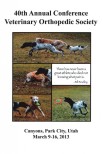OBJECTIVES: To investigate the conformation of the proximal tibia in small breed dogs with and without cranial cruciate ligament disease (CCLD) and to identify morphologic abnormalities that may predispose to development of CCLD.
METHODS: Mediolateral radiographs of the entire tibia of dogs <15 kg with surgically confirmed CCLD were retrospectively evaluated. Proximal tibial width (PTW), tibial plateau length (TPL), tibial plateau angle as described by Slocum and Slocum (sTPA), proximal tibial tuberosity angle (PTTA), tibial plateau angle as described by Inauen and colleagues (nTPA), and diaphyseal tibial width (DTW) were measured. The same variables were obtained from mediolateral radiographs of the entire tibia of dogs <15 kg without CCLD. In addition, a quotient nTPA/PTW, relative tibial tuberosity width (rTTW), and relative body weight (rBW) were calculated for each dog. Independent two-sample t-test (p = 0.05) was used to compare mean ± SD of all measured variables between the two groups.
RESULTS: Gender, age, and weight mean ± SD were not significantly different between the two groups of dogs (p <0.05). Dogs with CCLD had significantly greater sTPA (p = 0.015) and rBW (p = 0.016).
CLINICAL SIGNIFICANCE: In dogs of small breeds, a combination of an excessively steep tibial plateau and an increased relative body weight may predispose to early CCLD development. The slope of the tibial plateau was found to be caused by an abnormal caudal angulation of the proximal tibia, a phenomenon previously associated with CCLD development in small breed dogs in individual cases.
Conformation of the proximal tibia and cranial cruciate ligament disease in small breed dogs
Journal
Janovec J, Kyllar M, Midgley D, Owen M. Vet Comp Orthop Traumatol. 2017 May 22; 30 (3): 178-183.









